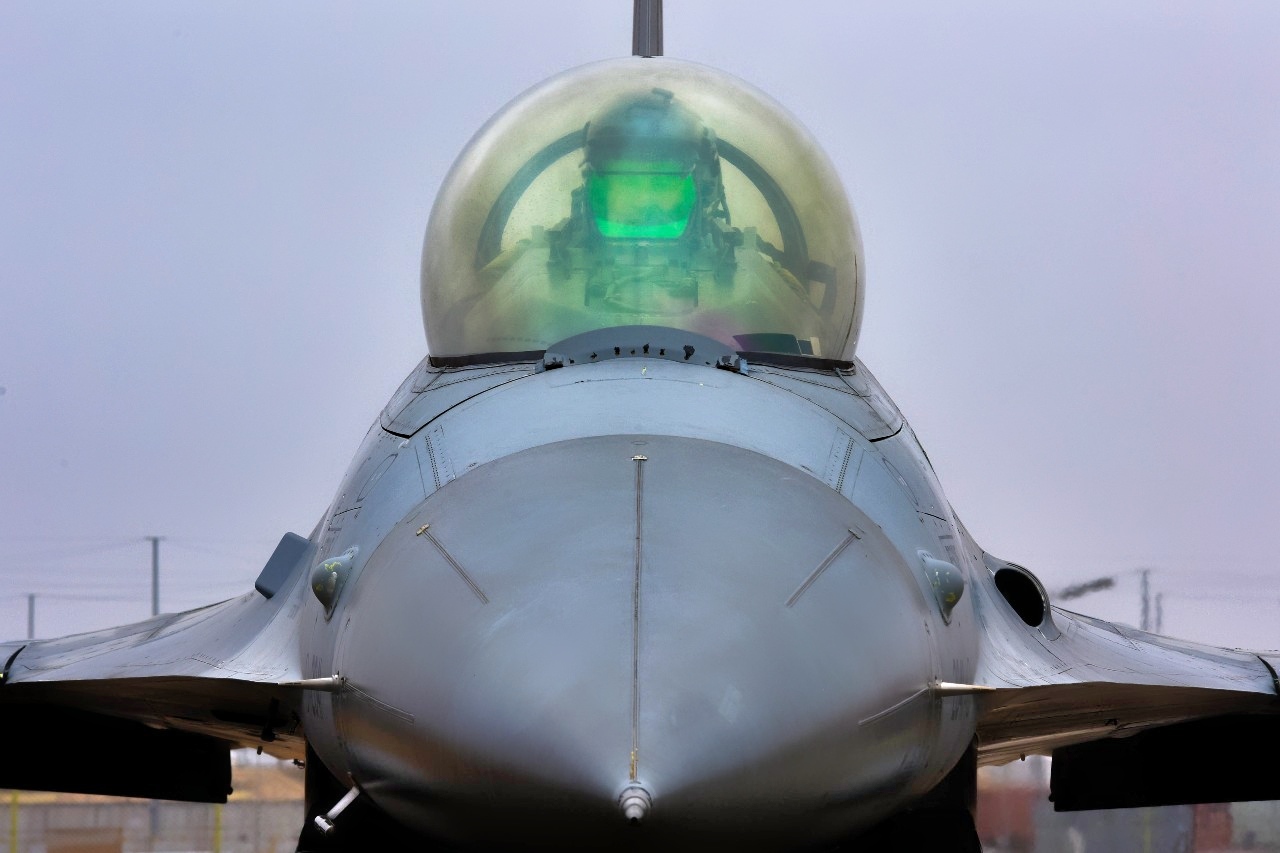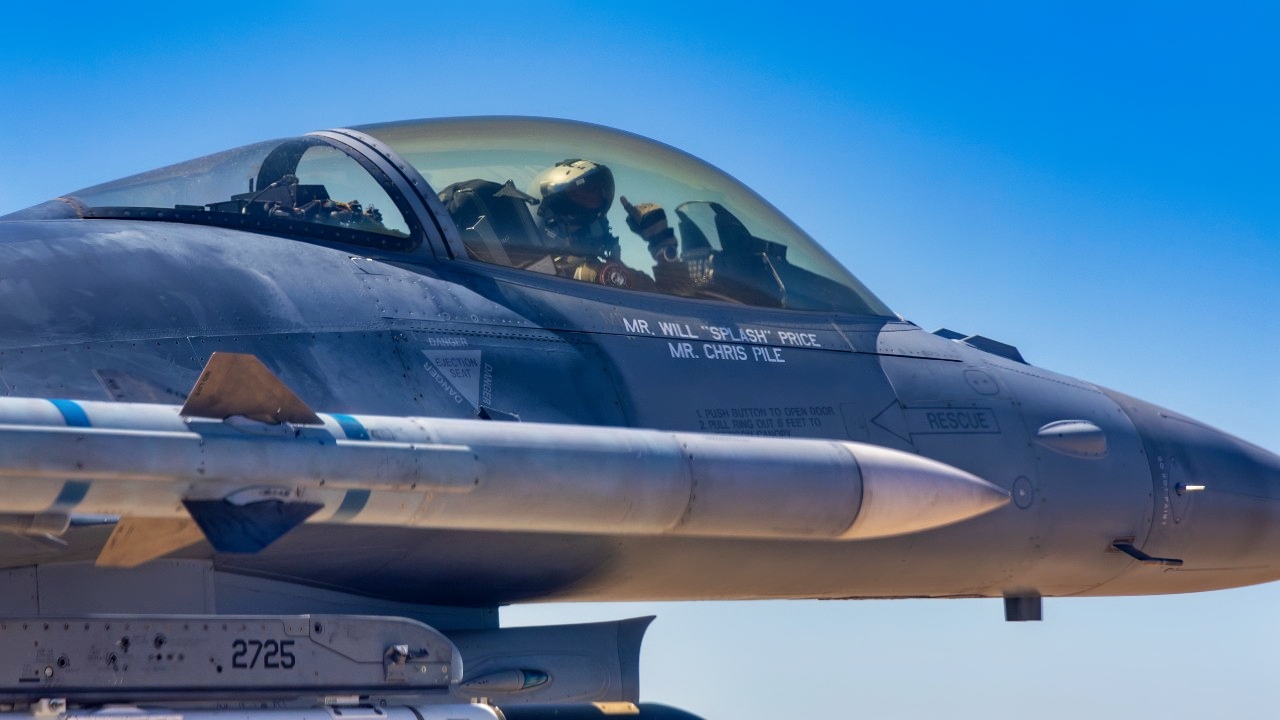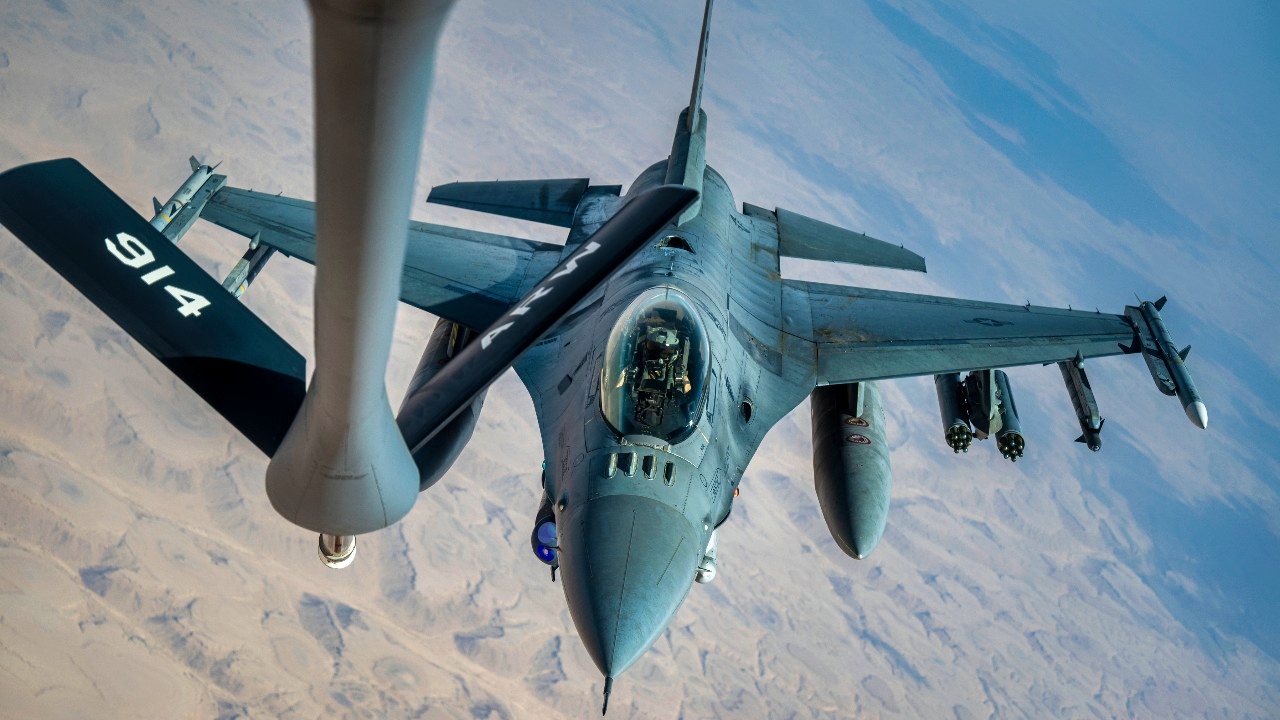Key Points and Summary – Nearly 50 years after first flight, the F-16 is a mature, reliable workhorse—but it had a rocky start. Early jets suffered F100 engine rollbacks and compressor stalls that forced test pilots to stay within dead-stick range.
-The Viper’s extreme agility also produced frequent G-LOC, driving better suits and tougher centrifuge training. Landing-gear “spin-up/spring-back” collapses exposed a design weakness later addressed with new actuators and hardware.

U.S. Air Force Lt. Col. John Ryan, 555th Fighter Squadron F-16 Fighting Falcon pilot, prepares to take off for a routine training flight at Aviano Air Base, Feb. 17, 2022. The flights will support NATO’s enhanced air policing mission; integrate with allies and partners in the Black Sea region in an increased defensive posture along NATO’s border and to reinforce regional security. (U.S. Air Force photo by Senior Airman Brooke Moeder)

Edwards AFB F-16C 88-456 with its special 50th Anniversary Fighting Falcon tail flash flies over the desert of Southern California. This Viper is assigned to the 416th Flight Test Squadron, flown by outgoing 416th FLTS Commander Lt. Col. Michael Pacini on his last flight with the Skulls. (Air Force photo by Todd Schannuth)

A U.S. Air Force F-16 Fighting Falcon prepares to receive fuel from a KC-135 Stratotanker over the U.S. Central Command area of responsibility, May 28, 2025. F-16s conduct combat air patrols within the USCENTCOM AOR to deter regional aggression and protect coalition partners. (U.S. Air Force photo by Airman 1st Class Christopher Lyons)
-Unlike modern stealth fighters, the F-16’s radar signature remains a limiting reality despite mitigation.
-And pilots still joke about cramped cockpits and “Falcon bites.” Those pains shaped upgrades that turned the F-16 into a classic.
The F-16’s Messy Start: Engine Rollbacks, G-LOC and Gear Woes
Nearly a half-century since the F-16 made its first flight, the platform has undergone extensive upgrades, incorporating new weaponry and sensor suites to leverage these and other new capabilities.
Today, the jet is regarded as a mature, reliable fighter platform—but that wasn’t always the case.
Here are a few factors that, particularly in the jet’s early years, garnered not-insignificant consternation.
Blast-off
The F-16 is well-regarded today as a highly capable, lightweight fighter capable of high-G maneuvers, making it extremely agile.
And while a half-century of tinkering with the aircraft and integrating components and technologies has made the F-16 a mature and reliable fighter today, that was not always the case.
Early in the jet’s development, it was regarded as temperamental and unreliable, a consequence of the jet’s borrowed components and subsystems.
“Air Force Systems Command test pilots and Tactical Air Command pilots flew the YF-16 and YF-17. By all accounts, the -16’s performance was phenomenal, but the aircraft had inherited a major problem from the F-15: the F100 engine,” one history penned by Smithsonian explains.
“Installed on the F-16, it had an alarming habit of refusing to provide more than idle thrust at the worst possible moments. On their first flights, Ettinger and retired Colonel Dean Stickell both experienced engine ‘rollbacks ‘; Ettinger didn’t even make it out of the chocks, but Stickell’s rollback occurred shortly after takeoff. Fortunately, he was at 15,000 feet and right over the runway at Edwards.”
“The engine was also prone to compressor stalls, a phenomenon that can produce spectacular flames out both ends of the engine, with explosions violent enough to knock a pilot’s feet off the rudder pedals. Until the engine problem was fixed, the YF-16 had to stay within deadstick landing distance of the base.”
Later F-16 project improvements, however, improved the F-16’s capabilities, and today the jet enjoys a reputation for high performance and reliability.
Sleep Time
Today, the F-16’s engine enjoys a stronger reputation for reliability.
However, its high thrust, combined with the fighter’s light weight, meant that early F-16 pilots routinely blacked out during high-G maneuvers.
Though pilot G-suits were improved to keep pilots’ blood pumping even during particularly taxing maneuvers, the U.S. Air Force Tactical Air Command decided to intensify centrifuge high-G pilot training to help them avoid losing consciousness when flying the highly maneuverable jet fighter.
Broken Leg
One 2019 F-16 accident in South Korea, though non-fatal, resulted in the loss of an F-16 and shed some light on a long-standing issue with the F-16 fighter: its landing gear. During a routine landing, the F-16’s right main landing gear collapsed.
Although the pilot attempted to save the aircraft, the F-16 crashed, resulting in a total loss. The pilot managed to eject and escape with only minor injuries.
As an official Air Force analysis of the F-16 crash noted, “There is historical evidence, as far back as 1993, of F-16C main landing gear (MLG) collapsing upon initial touchdown and subsequently re-locking into a safe condition. Air Force Material Command, the Air Force Sustainment Center, and Lockheed Martin Aero have all studied and published reports on F-16C MLG collapsing and sometimes re-locking into place. This F-16C MLG failure phenomena is commonly known as the spin-up/spring-back condition.”
That condition occurs when the vibrational forces generated by landing overcome the springs that lock the landing gear in place, leading to a collapse.
The investigation also noted that the Air Force had been aware of this phenomenon as early as 1997. It had issued a solution—the replacement of “a new actuator, bracket assembly, and attaching hardware” to address the shortcoming.
A Fading Fourth Generation in the F-16
Despite the F-16’s many strengths, perhaps the platform’s most long-term shortcoming is its lack of radar-mitigating features and inability to evade adversary radar to the same degree as stealthy fifth and sixth-generation aircraft.
Instead, the F-16 predates those generations of aircraft that, in the United States, began with the introduction of the F-117 Nighthawk and the B-2 Spirit bomber. However, despite the F-16’s much more modest stealth profile, the jet does employ some radar-mitigation measures.

A U.S. Air Force F-16 Fighting Falcon piloted by Maj. Josiah “Sirius” Gaffney, Pacific Air Forces’ (PACAF) Demonstration (Demo) Team commander, sits on the tarmac shortly after landing during the PACAF F-16 Demo Team Practice Flight at Misawa Air Base, Japan, April 21, 2021. Although COVID-19 has postponed air shows, the demo team continues training to make sure they are ready to showcase the F-16 capabilities. (U.S. Air Force photo by Airman 1st Class Leon Redfern)
However, despite the measures taken to reduce the F-16’s radar detectability, the jet remains a Cold War-era fighter, one built before today’s radar-mitigation practices became commonplace.
Although helpful, the incremental stealth measures integrated into the jet do help reduce the jet’s radar detection; however, the F-16 is not a stealth fighter.
And in an age increasingly dominated by mature stealth aircraft, the applicability of a jet like the F-16 to today’s conflicts is increasingly vanishing.
Pint-sized Pilots Wanted
Perhaps one of the more humorous of the F-16’s design shortcomings relates to its height relative to the ground.
As a 6-foot-1 F-16 pilot explained, so-called “Falcon Bites” bumps, bruises, and pinching caused by getting a body part jammed into the fighter’s landing gear actuators, canopy, or elsewhere, were a relatively common occurrence.
And inside the F-16’s notoriously cramped cockpit, pilots and flight instructors on the taller side of six feet might find the jet’s internal geometry decidedly cramped.
NOTE: We have corrected a typo in the headline.
About the Author: Caleb Larson
Caleb Larson is an American multiformat journalist based in Berlin, Germany. His work covers the intersection of conflict and society, focusing on American foreign policy and European security. He has reported from Germany, Russia, and the United States. Most recently, he covered the war in Ukraine, reporting extensively on the war’s shifting battle lines from Donbas and writing on the war’s civilian and humanitarian toll. Previously, he worked as a Defense Reporter for POLITICO Europe. You can follow his latest work on X.
More Military
Europe’s New 6th Generation GCAP Stealth Fighter Looks Unaffordable
49 ‘New’ M1A1 Abrams Tanks Were Sent to Ukraine by Australia and America Doesn’t Approve
The U.S. Marine Corps Is Facing a Tough Drone Reality
‘300 Percent More Lethal’: The U.S. Army Is Putting China and Russia on Notice











Jon Miknis
November 11, 2025 at 11:11 am
Maybe you should double check spelling and accuracy before publishing an article titled the “Mach 20.5 F-15 fighting falcon”. F-15 eagle. F-16 falcon or viper. The F-15 has a top Mach speed of 2.5 Mach while yes the F-16 has a top speed of Mach 2.05.